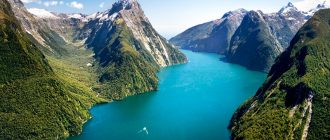Switzerland – the most detailed information about the country with a photo. Attractions, cities in Switzerland, climate, geography, population and culture.
Contents
- 1 Switzerland (die Schweiz)
- 2 Useful information about Switzerland
- 3 Geography and nature
- 4 Climate
- 5 Best time to visit
- 6 Story
- 7 Administrative division
- 8 Population
- 9 Transport
- 10 Cities of Switzerland and popular destinations
- 11 Sights of Switzerland
- 12 Accommodation
- 13 Kitchen
- 14 Video
- 15 Switzerland on the map
Switzerland (die Schweiz)
Switzerland is a state in Central Europe. This is one of most beautiful and richest countries in the world, most of the territory which occupy the mountains (Alps and Jura). Switzerland is bordered by Italy in the south, Germany in the north, Austria and Liechtenstein in the east, France to the west. This federal parliamentary republic, which is divided into 20 cantons and 6 semi-cantons. Population speaks german, french, italian and professes Christianity (while the proportion of Catholics and Protestants is approximately equals).
The name of the state comes from the canton of Schwyz, one of the three cantons that founded the Confederation. Switzerland is a country of amazing Alpine landscapes and picturesque small towns, blue lakes, which reflect mountains and glaciers, and green valleys. This is a country banks and watches, cheese and chocolate, which for centuries has been its neutrality. Switzerland is famous for its remarkable cultural heritage, stunning nature and ski resorts class.
 Switzerland flag
Switzerland flag
- Useful information
- Geography and nature
- Climate
- Best time to visit
- Story
- Administrative division
- Population
- Transport
- Cities of Switzerland
- sights
- Accommodation
- Kitchen
Useful information about Switzerland
- Official languages are German, French, Italian and Romansh (or Swiss).
- Currency – Swiss franc.
- Visa – Schengen.
- The standard of living is very high.
- The population is more than 8 million people.
- Area – 41 284 km².
- The capital is Bern.
- Time – UTC +1, summer +2.
- Switzerland is one of the safest countries in the world with very low crime rate.
- Tax Free – available only with purchases costing more than 300 francs.
- Holidays: January 1 – New Year, January 2 – Holy Day Berthold, Good Friday (April-May), Easter (April-May), Monday of Holy Week (the first after Easter), May 1 – Day Labor, Ascension (May-June), Pentecost and Spirit Day (May-June), the Feast of the Body of the Lord (usually in June), August 1 – Swiss National Holiday, August 15 – The Ascension of the Virgin Mary, November 1 – All Saints Day, December 8 – Immaculate Day Conception of the Blessed Virgin Mary, December 25 – Christmas, December 26 – Boxing Day.
Geography and nature
Switzerland is located almost in the center of Europe and occupies important strategic position between the North and the South of the continent. Geographically, the country can be divided into:
- Jura – a mountainous region in the northwestern part Switzerland.
- Swiss plateau or Mittelland – the central part of the country, sandwiched between the Alps and the Jura. Represents a hilly the plain.
- Alps – the largest mountain range in Switzerland, which occupies 61% of its territory. Divided into the Pennine Alps, Lepontine The Alps, the Retie Alps and the Bernina Massif.
In terms of relief, most of Switzerland is mountainous. Average height above sea level exceeds 500 meters. Highest point Switzerland – Dufour peak (4634 m), the lowest – Lake Maggiore – 193 m
 Swiss Alps
Swiss Alps
In the mountains of Switzerland are the origins of the largest rivers of Europe: the Rhone and Reina. Also, the country is known for a large number of picturesque lakes: Geneva, Firvaldshtetskoe, Thunsky, Zurich, Bielskoe, Neuchâtel, Lago Maggiore. Most of them have glacial origin. By the way, there are many in the mountains of Switzerland glaciers.
The nature of Switzerland is quite rich and diverse. 1/4 part the territory of the country is still covered with forests. In the forests dominated by oak and beech, in the mountains – spruce, pine, fir. In the mountains and forests of Switzerland live deer, roe deer, chamois, foxes, hares, partridges.
Climate
Predominant is the continental climate type. Climate mountainous areas due to high-altitude zonality. In the west of the country the climate is much milder, whereas in the east and south it is much more severe.
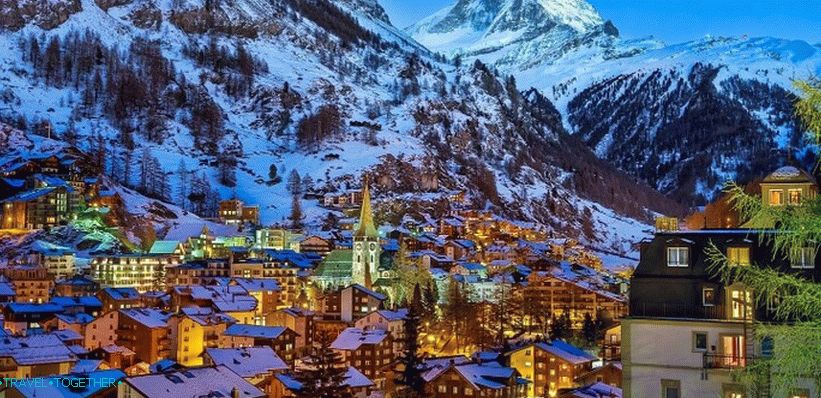 Winter in Switzerland
Winter in Switzerland
Best time to visit
Switzerland is open to tourists all year round and every season around. its good If the main goal of its ski resorts, then you need come in the winter. To study the cultural heritage of the country and attractions are quite suitable off season. To travel around mountains and lakes are best to visit Switzerland in the summer.
 Switzerland in the autumn
Switzerland in the autumn
Story
The territory of Switzerland was settled in the Stone Age. During the period the existence and flourishing of the Roman Empire (from the 5th century BC to 4 Century AD) Celtic tribes (Helvets) lived here. East Switzerland was inhabited by Retians who were related to Etruscans. In the 2nd century BC, local tribes raided the Roman Empire. and even inflicted several defeats on the Romans. Switzerland was subordinate in 52 BC, when the Gauls rebellion was suppressed against the power of Rome. In the 3rd century AD, the Romans began to lose their position under the pressure of the Germanic tribes. By the 5th century north of Switzerland the Alamanni captured, and the West the Burgundians.
 Swiss remote place
Swiss remote place
In the Middle Ages, Switzerland was fragmented into several kingdoms that were subject to the Franks during the reign Charlemagne in the 8th century. Christianization of the population began at 4 century. In 843, the territory of Switzerland was divided between Italy and Germany. At the beginning of the 10th century, the entire territory of the country was subordinated by the kings of Germany and in 1032 became part of the Holy Roman the empire, which ruled over 3 centuries.
 Winter in The alps
Winter in The alps
In the 11-13th century, trade developed in Switzerland and new ones appeared. cities. This was the reason for the emergence of new trade routes. One of The main trading arteries of Switzerland were of great importance and passed through the valleys of the Uri, Schwyz, Graubünden and the St. Gotthard pass. During this period, the power in the Holy Roman Empire came to power. Habsburg Fearing their pressure, August 1, 1291 was a military treaty was concluded that united Uri, Schwyz and Unterwalden. This date is considered the foundation of the Swiss Union and Swiss statehood. In the 14th century, the Habsburgs repeatedly tried to take control of the cantons, but suffered a few lesions.
In the 14th century, the composition of the Swiss Union was replenished with Zurich, Lucerne and byrne. This led to an increase in tension between the cantons, which resulted in the Zurich War. Interestingly, major cities in confederations were granted free status, had wide autonomy and led a lively trade with other cities in Europe. In the 15th century to The Swiss Union joined the new cantons. In 1499 Holy Roman Empire attempted to regain control of recalcitrant territories, but suffered defeat. By the way about during this period the first principles of the Swiss were laid neutrality.
 Landscapes Switzerland
Landscapes Switzerland
In the first half of the 16th century in Switzerland begins the period Reformation. In 1648 the Treaty of Westphalia was concluded, which enshrined the independence of Switzerland. In the 17-18 century, life in The state was peaceful. This period in Switzerland develops industry, and the country itself is getting richer in loans, turning into one of the main financial centers of Europe.
At the end of the 18th century in the French-speaking cantons of Switzerland broke out revolution. German-speaking cantons led by Bern tried her suppress but this led to the occupation of france and education Helvetic Republic. During this period, the first was adopted The constitution is modeled on the French. After the withdrawal of French troops In 1802, the restoration of the old order began. In 1803 Napoleon returned feudalism to Switzerland, gave a new constitution and increased the number of cantons. In 1814-1815, the Congress of Vienna and The Paris Peace Treaty secured the independence of Switzerland and its neutrality.
 Lake Firwaldstet
Lake Firwaldstet
In 1848, a new constitution was adopted in Switzerland. From 1850 , the single currency became the franc, and the capital is Bern. In 1844 was The first railway from Basel to Strasbourg was laid. In the first and World War II, Switzerland took the side of the military neutrality. Although during the Second World War, collaborated with by the fascists. In 1999, a new constitution was adopted. At present Switzerland is one of the richest countries in the world. On her the territory operates one of the largest physical laboratories – CERN Also in Switzerland, the birth of the Internet occurred. Here The first site, browser and web server was developed.
Administrative division
In the administrative-territorial plan, Switzerland is divided into 20 cantons and 6 semi-cantons. The cantons are divided into counties which, in turn divided into cities and communities.
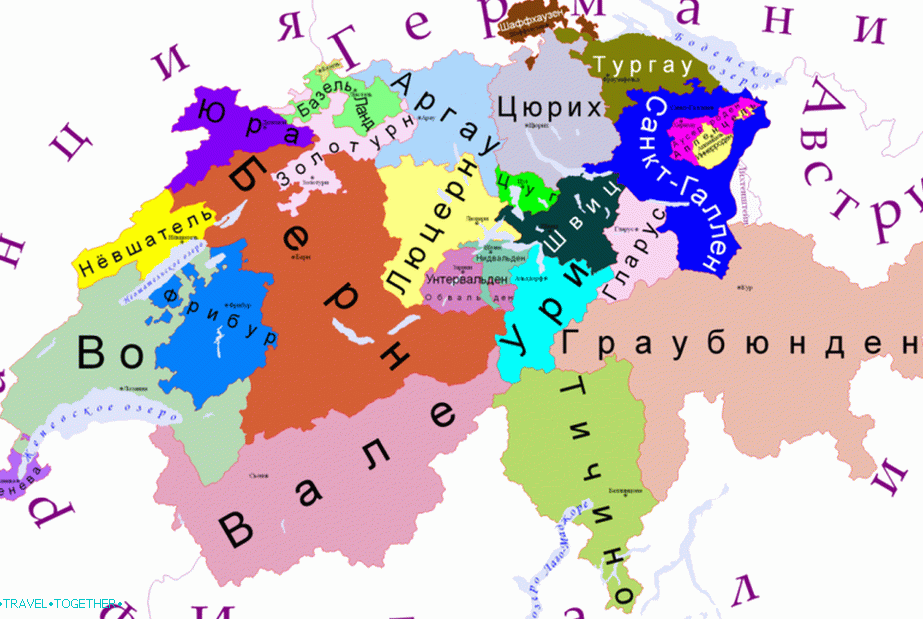 Cantons Switzerland
Cantons Switzerland
Cantons of Switzerland:
- Zurich
- Berne
- Lucerne
- Uri
- Obwalden
- Schwyz
- Nidwalden
- Yura
- Geneva
- Neuchâtel
- Vale
- In
- Ticino
- Thurgau
- Argau
- Graubunden
- St. Gallen
- Glarus
- Zug
- Friborg
- Solothurn
- Basel-Stadt
- Basel-Land
- Schaffhausen
- Appenzell Ausserrhoden
- Appenzell Inner Roden
 Swiss landscapes
Swiss landscapes
Regionally, a country can be divided into:
- Northwest Switzerland – Basel, Aargau, Solothurn.
- Zurich Region.
- Central Switzerland – Lake Lucerne and the cantons of Uri, Obwalden, Nidwalden, Schwyz.
- Eastern Switzerland – the area between the origins of the Rhine and the Constance Lake (Thurgau, Appenzell-Ausserrhoden, Appenzell Inner Rhodes, St. Gallen).
- Lake Geneva Region – French-speaking Switzerland (Cantons of Geneva, Bern, Valais, Friborg).
- Southern Switzerland – Italian-speaking region (canton Ticino).
Population
Interestingly, 90% of Switzerland’s population considers itself to be ethnic swiss At the same time, the country does not have a single language. Language composition: German Swiss (65%), frankweiz (18%), Italian and Swiss (10%). Therefore, the most common language, everything same, is german. In religious terms, the vast majority are Christians (half of whom are catholics and the other is Protestants).
Transport
Switzerland’s largest airport is located in Zurich. Other international airports are located in Basel, Geneva, Lugano, Bern and St. Gallen. The country is connected by modern highways with Germany and Austria.
For driving on the Swiss motorways vignette. Its cost is 40 francs and it acts alone. year. The penalty for the lack of vignettes – 200 francs.
 Eiger, neighborhood of Bern
Eiger, neighborhood of Bern
Switzerland has one of the most developed railway in Europe networks, so traveling around the country by train is very convenient. Also, many railways are very scenic. Regular railway communication is available with almost all neighboring countries Europe. You can also get to Switzerland by bus from some States of Eastern Europe, Spain and Portugal.
Speed limits: 50 km / h – settlements, 80 km / h – out settlements, 120 km / h – motorway. Penalties for exceeding speeds are very high.
Acceptable control of the vehicle at a blood alcohol content of not more than 0.5.
Cities of Switzerland and popular destinations
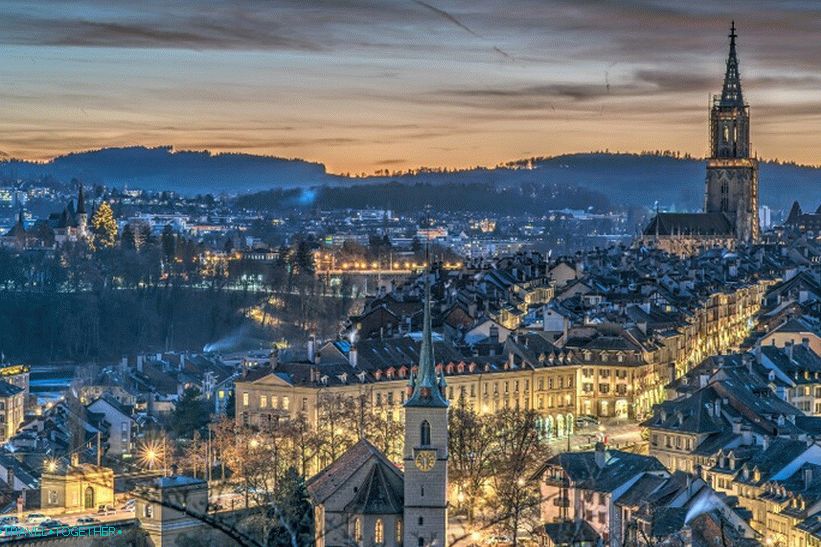 Bern – the capital of Switzerland
Bern – the capital of Switzerland
The capital of Switzerland is Bern. This is a picturesque old town. with a beautiful medieval historical center that is included in UNESCO World Heritage List.
 Zurich
Zurich
Zurich is the largest city and transportation hub of Switzerland. Is an one of the most dynamic Swiss cities with beautiful architecture, plenty of entertainment and opportunities for leisure time
 Geneva
Geneva
Geneva is the capital of the eponymous canton located on the coast picturesque Lake Geneva. It is a city of banks and museums, parks and galleries where the UN headquarters are located Europe.
 Basel
Basel
Basel is the cultural capital of Switzerland with a beautiful old town and rich nightlife. This city is located on the River Rhine at border with France and Germany.
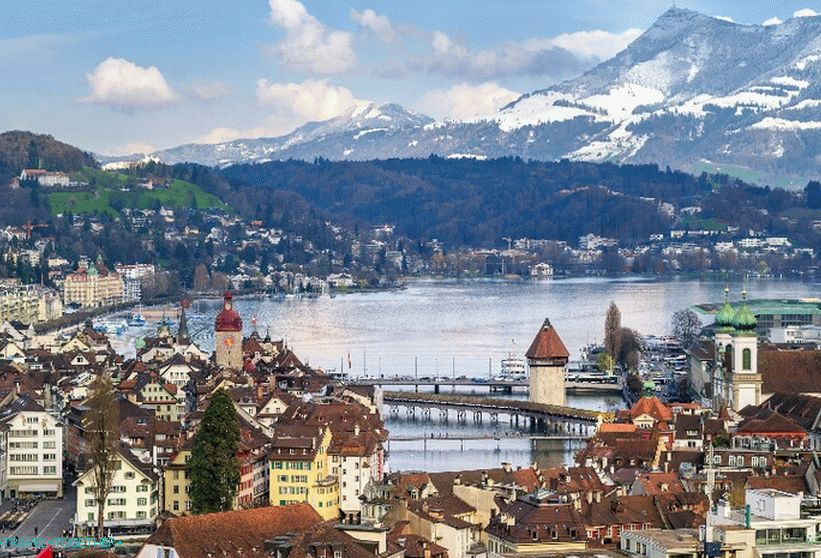 Lucerne
Lucerne
Other popular cities:
- Lausanne is the capital of the Swiss canton of Vaud. This small town It is the seat of the International Olympic Committee and a major university center.
- Lucerne is one of the most beautiful and popular cities in Switzerland. Located nm coast of the lake of the same name on the border of the Alps.
- Lugano is the capital of southern Switzerland and the canton of Ticino. Is famous for beautiful nature and cultural component of the rest.
- Interlaken is a small resort town located between Thunsky and Brienz lakes.
Switzerland strikes with a whole scattering of picturesque small towns, who seemed to be off the postcard.
Sights of Switzerland
Old cities and historical sights
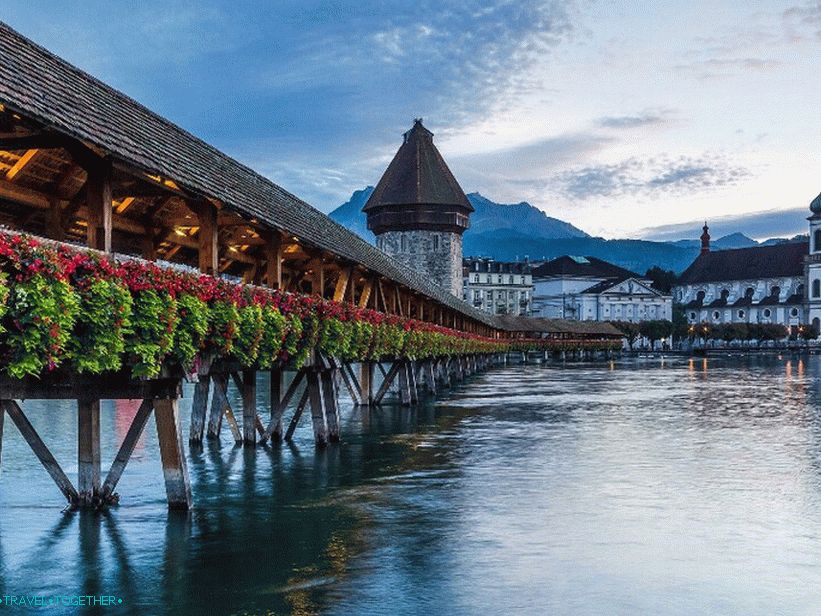 Lucerne
Lucerne
The old town of Lucerne is located on the shores of a picturesque lake, surrounded by mountains. It is a medieval core with old houses, bridges and landmarks. Main Lucerne’s symbols are the 14th century bridge chapel and the famous sculpture “The Dying Lion”.
For beautiful landscapes and views visit site
 Chillon Castle
Chillon Castle
Chillon Castle in Montreux – a magnificent castle on the banks of Geneva lakes It was built in the 12th century and for a long time remained a residence. Savoy dynasty.
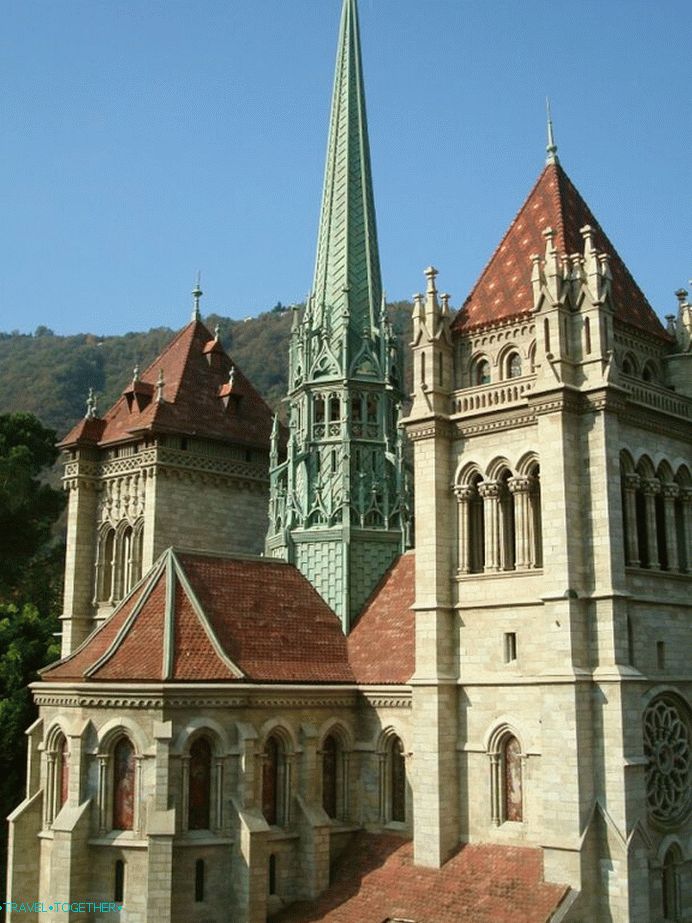 Saint Pierre
Saint Pierre
Saint-Pierre – the cathedral, the pearl of the old city of Geneva. It was built in the 12th century and contains a large number of Romanesque and gothic elements.
 Cathedral of sv. Nikolay
Cathedral of sv. Nikolay
Cathedral of sv. Nicholas – a beautiful Gothic church in the city of Friborg. Friborg itself is considered one of the most beautiful medieval cities. Europe.
 Sion
Sion
The old town of Sion is one of the most picturesque in Europe. is he located on the river Rhone and has a charming medieval the atmosphere. The most famous sights: the cathedral Cathedral, Witch Tower and Bishops Castle.
 Oberhofen
Oberhofen
Oberhofen – romantic medieval castle on the banks of Thunsky lake, turned into a museum. Adjacent to the castle is a large and beautiful a park.
 Cathedral Notre Dame
Cathedral Notre Dame
Notre Dame Cathedral is the most prominent example of the Swiss Gothic, grand medieval cathedral located in Lausanne.
 Old city Berna
Old city Berna
Bern’s old town is a labyrinth of cobbled streets and ancient houses, the highest cathedral in Switzerland and the medieval tower with for hours.
 Zurich
Zurich
The charming old town of Zurich with beautiful architecture and interesting sights. Here you can find more than 50 museums and 100 art galleries. Bahnhofstrasse in Zurich – one of the best shopping streets of Europe with trendy designer shopping.
Natural Attractions of Switzerland
 Matterhorn
Matterhorn
Matterhorn is one of the most famous mountains in Europe. This the legendary peak is located in the Pennine Alps and has a height of 4478 m
 Jungfraujoch
Jungfraujoch
Jungfraujoch – one of the most popular natural Sights of Switzerland, located in the Bernese Alps. At an altitude of 3445 meters is an observatory and a viewing site, as well as the largest glacier in Europe and the famous trail to mountains eiger. At the foot of the mountains is a picturesque ski resort Grindelwald
 Interlaken
Interlaken
Interlaken is one of the most popular summer resorts in Switzerland. located between picturesque lakes. Offers over 45 scenic mountain railways, cable cars and lifts.
 Geneva lake
Geneva lake
Lake Geneva is the largest alpine lake located on border of Switzerland and Austria.
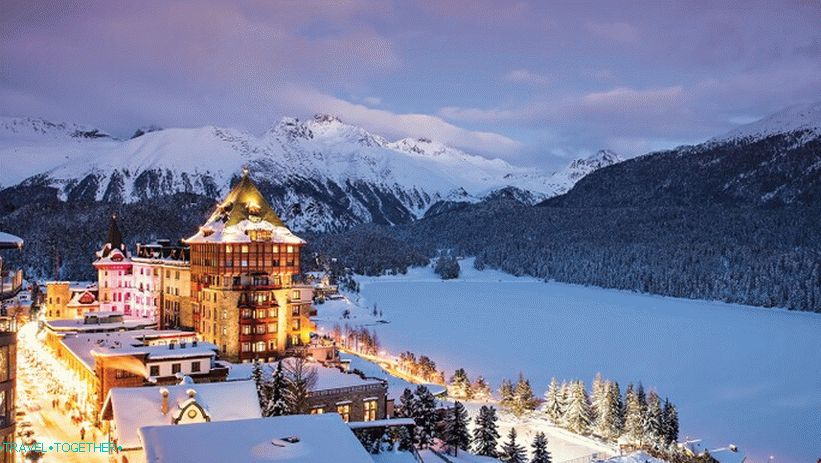 St. Moritz
St. Moritz
St. Moritz – one of the most famous ski resorts Switzerland. Located among the beautiful alpine lakes, jagged tops and forests.
 Lake lugano
Lake lugano
Lake Lugano – the pearl of the canton of Ticino. Here among the alpine peaks grow subtropical plants, and the neighborhood is saturated the flavor and atmosphere of Italy.
 Rhine waterfalls
Rhine waterfalls
The Rhine Falls are the largest waterfalls in Central Europe. Located near the town of Schaffhausen.
Accommodation
Finding accommodation in Switzerland is not a problem. The country is very popular tourist destination, so here is located A large number of hotels, guest houses and even campsites of different price categories. On average, the cost of living in Switzerland quite tall. Although if you start your home search in advance or come in the offseason, you can find great options.
 Hotel in The alps
Hotel in The alps
Kitchen
Swiss cuisine formed under the influence of culinary traditions of Italy, Germany, France. Switzerland historically is a country with a developed agriculture, so most traditional dishes are easy to prepare. In many cantons Regional cuisine is available.
 Fondue
Fondue
Popular food:
- Fondue – melted cheese with slices of bread.
- Raclette – a dish similar to fondue.
- Rösti is a popular potato dish.
- Birchermüesli – Muesli.
- Älplermagrone – casserole with onions and cheese.
- Zürcher Geschnetzeltes – veal with mushrooms in cream sauce.
- Malakoff – fried cheese balls or sticks.
- Apple Rösti is a sweet dish with apples.
- Tirggel – Christmas biscuits.
- Polenta, risotto and pizza in southern Switzerland.
Traditional products: cheese, sausages, chocolate, meringue, wine.





